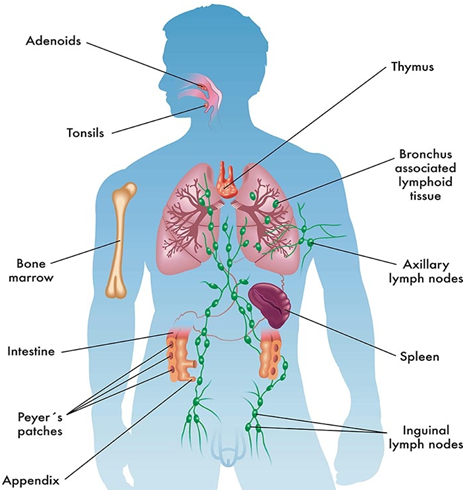The immune system is a complex system which consists of collection of cells, organs, tissues and molecules that work together to protect an organism or animal from disease and invading foreign agent’s (i.e. pathogens). For the immune system to function properly and constantly keep the integrity of the human body intact and free from microbes, it must identify non-self from self and then mount an immunological attack on the non-self-molecules. With its associated cells, organs and tissues, the human immune system is capable of mounting targeted and specific immunological response against any invading pathogen and other foreign bodies that gain entry into the body.
All living organisms including humans are subjected to constant attack by disease causing organisms (pathogens) due to the hostile environment in which they live, and it is the job of the immune system to continually protect the body from pathogens and ensure that it is disease-free as much as possible. Because there are an increasing number of pathogens that longs to gain entry into the intact human body, the immune system constantly evolves its mechanisms to better detect and respond appropriately to foreign bodies.
Upon detecting an antigen (which could comprise of a bacterium, fungus, virus or protozoan), the immune system uses its cells and associated structures to properly distinguish them from the normal healthy tissues and cells of the host. It is noteworthy that the actual components of the immune system are cellular in nature and not necessarily associated with any specific organ or tissue. The immune system components are widely present in the blood and fluid circulation throughout the body of every animal host (inclusive of humans).
The immune system of animals is amazingly powerful in that it can recognize specifically countless number of pathogens that attack the body and cause disease, and in its sole task of ensuring an immune state of the host’s body, it in-turn produce specific molecules that wade-off the deleterious effects of the antigens. However, diseases can emanate when and if the immune system becomes disrupted or malfunctions; and this could result into the development of diseases collectively known as autoimmune diseases or disorders (e.g. rheumatoid arthritis and systemic lupus erythematosus amongst others).
Autoimmune diseases are diseases caused by an attack of the immune system on an individual’s own body tissues (i.e. self-molecules). The immune system is thus the natural defense of combating diseases and microbial invasion of the human body but when this natural mechanism of fighting infectious diseases becomes compromised (e.g. in HIV/AIDS infection) or fails to regulate its immune responsiveness especially in the discrimination of self-molecules from non-self-molecules (i.e. antigens) several untoward effects including immunodeficiency diseases and autoimmune diseases occur in the host.
The primary function of the immune system in a living organism is to distinguish between self and non-self-molecules or foreign bodies. In its task of protecting the body from infectious agents and safeguard it from the development of disease, the immune system responds by mounting series of reactions known as immune response – which collectively develop immunity (resistance) to only non-self-molecules without attacking the body’s own molecules recognized as self.
The immune system responds in two basic ways to non-self-molecules or antigens, and these are:
- Innate immune response: The major purpose of the innate immune response after pathogen invasion of the body of a host is to attract immune system cells such as antibodies to the site of an infection in the body. And once this has been established, the adaptive immune response (which is more specific in nature than the innate immunity) is attracted to the site of infection and stimulated to produce targeted immune responses that inhibit or kill the invading pathogen or antigen; and thus restore the host to its normal body function.
- Adaptive immune response: Adaptive immune response is antigen-specific; and it recognizes and destroy a particular antigen in a host especially based on previous exposure of the host to the invading pathogen(s). However, both the innate and adaptive immune response works together in our body system to mount an effective and specific immune response upon pathogen exposure or invasion.
The resistance of the body to disease and foreign bodies is usually based on these two mechanisms of immune response i.e. the innate and adaptive immune response. The immune response of the immune system recognizes antigens and immediately mounts a biological reaction to eliminate it while helping the system to recognize it and mount a rapid attack the next time similar foreign agent invades the body.
Also, the adaptive immune system of animals can be divided into two groups as follows:
- Humoral immunity or antibody-mediated immunity (AMI)
- Cell-mediated immunity (CMI)
REFERENCES
Abbas A.K, Lichtman A.H and Pillai S (2010). Cellular and Molecular Immunology. Sixth edition. Saunders Elsevier Inc, USA.
Actor J (2014). Introductory Immunology. First edition. Academic Press, USA.
Alberts B, Bray D, Johnson A, Lewis J, Raff M, Roberts K and Walter P (1998). Essential Cell Biology: An Introduction to the Molecular Biology of the Cell. Third edition. Garland Publishing Inc., New York.
Bach F and Sachs D (1987). Transplantation immunology. N. Engl. J. Med. 317(8):402-409.
Barrett J.T (1998). Microbiology and Immunology Concepts. Philadelphia, PA: Lippincott-Raven Publishers. USA.
Jaypal V (2007). Fundamentals of Medical Immunology. First edition. Jaypee Brothers Medical Publishers (P) Ltd, New Delhi, India.
John T.J and Samuel R (2000). Herd Immunity and Herd Effect: New Insights and Definitions. European Journal of Epidemiology, 16:601-606.
Levinson W (2010). Review of Medical Microbiology and Immunology. Twelfth edition. The McGraw-Hill Companies, USA.
Roitt I, Brostoff J and Male D (2001). Immunology. Sixth edition. Harcourt Publishers Limited, Spain.
Zon LI (1995). Developmental biology of hematopoiesis. Blood, 86(8): 2876–91.
Discover more from #1 Microbiology Resource Hub
Subscribe to get the latest posts to your email.



